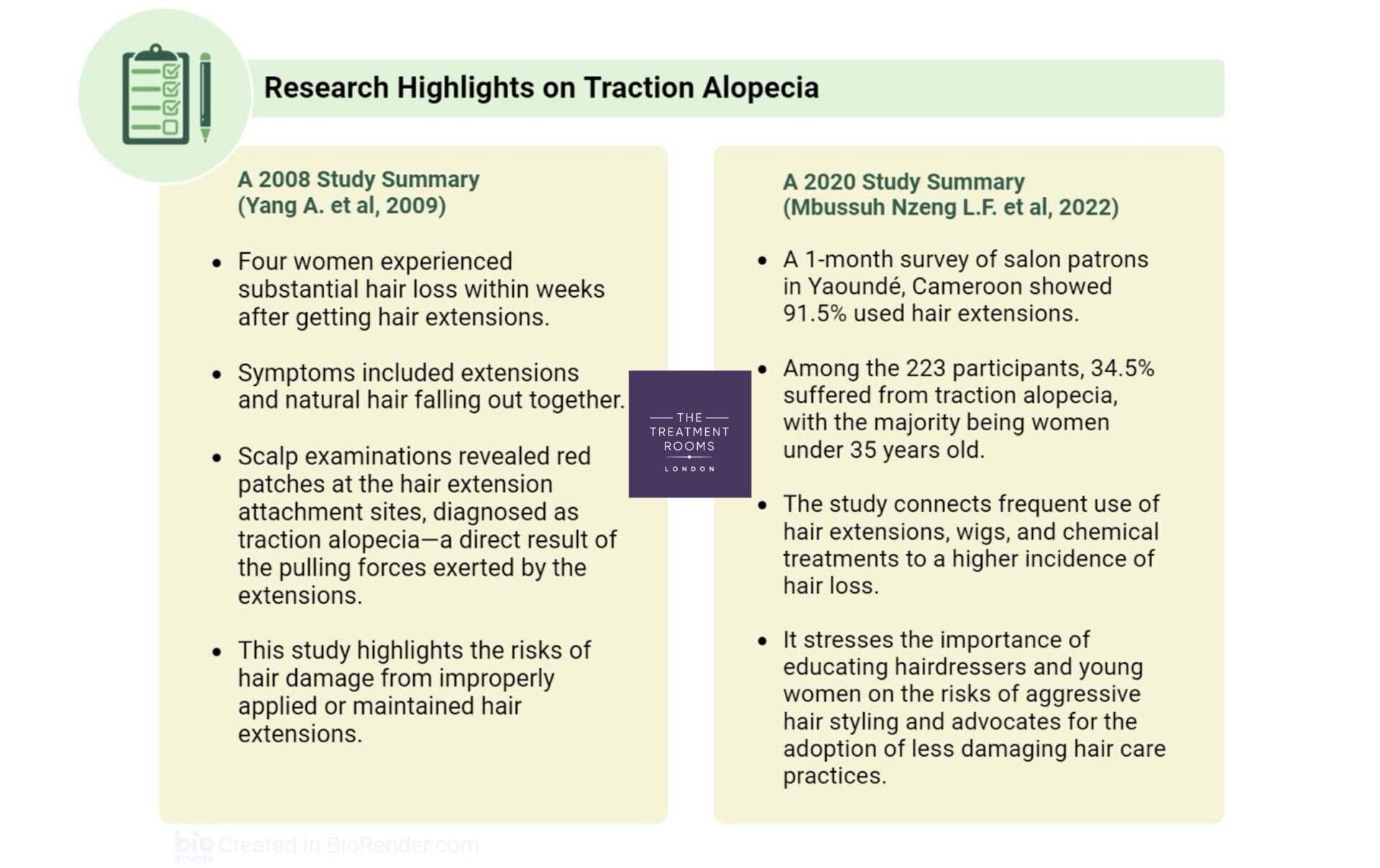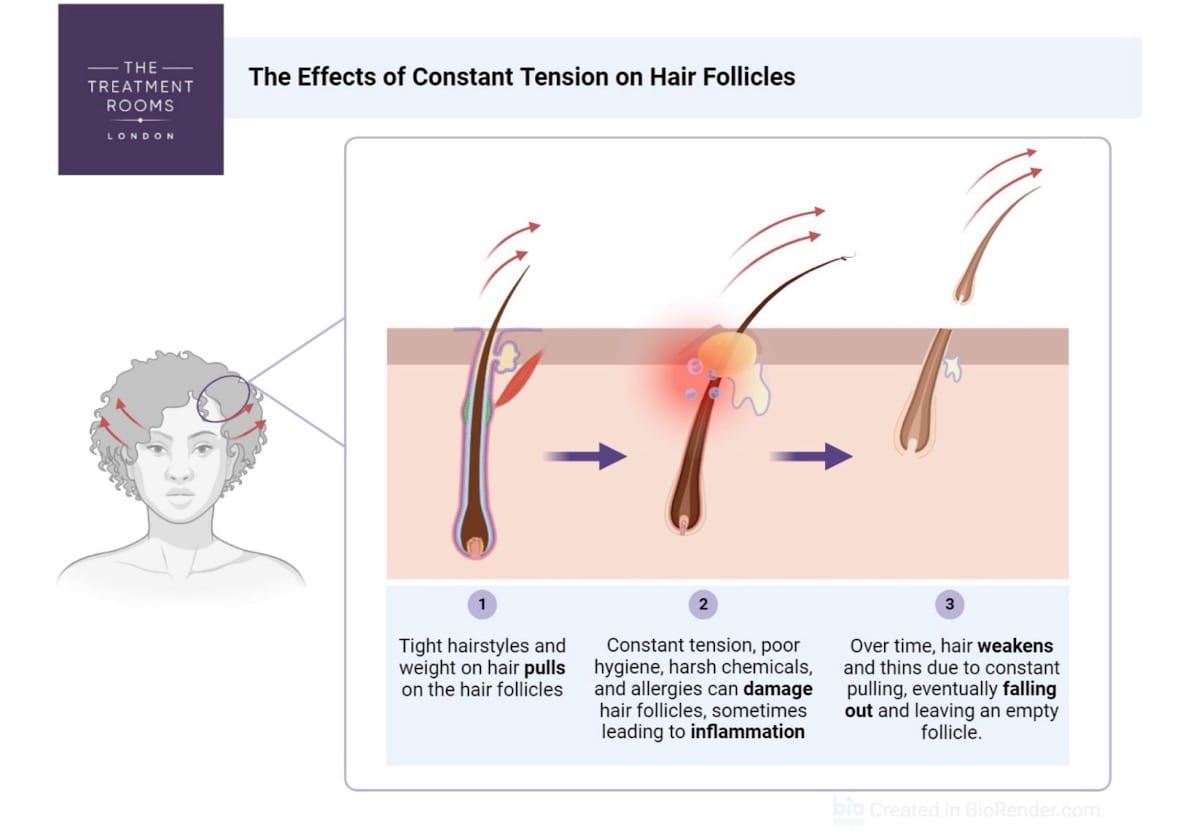Hair Extensions And Hair Loss – What You Need To Know
Quick Summary: Hair Extensions and Hair Health
About Hair Extensions: Hair extensions are versatile styling tools that add length and volume to hair, offering an instant transformation. However, they must be correctly applied and maintained to prevent potential hair damage, such as traction alopecia.
Potential Risks of Hair Extensions: Hair extensions can cause traction alopecia, a form of hair loss due to constant pulling on the hair, if not applied or maintained properly. Other risks include stress on hair follicles from the weight of the extensions, chemical damage from adhesives, and scalp irritation leading to hair loss.
Safe Practices for Using Hair Extensions: To ensure hair health, choose a skilled stylist for proper extension application. At home, use gentle handling during application and removal, maintain scalp hygiene, and take care with delicate hairline edges to avoid undue tension in the area.
Alternatives to Hair Extensions: For those seeking less risky options to manage hair thinning or loss, alternatives include hair thickening products, nurturing natural hair growth and considering less straining hairstyles like loose braids and soft waves.
Seeking Expert Advice: For comprehensive hair loss solutions, and to better understand the underlying causes of hair loss, consulting with healthcare providers or hair restoration specialists is crucial. They can offer tailored advice and treatment options, including potential hair transplant surgery if appropriate.
Key Takeaway: Hair extensions are a popular cosmetic solution that allows individuals to enhance their appearance by adding length and volume to their hair. While they provide an immediate transformation, it’s crucial to understand the potential risks of their use, and the importance of proper application and maintenance to avoid hair damage and loss. This comprehensive blog will explore the relationship between hair extensions and hair loss, outline safe practices for using hair extensions, and discuss alternatives that pose less risks of hair loss.
What Are Hair Extensions?
Hair extensions are specialised products designed to enhance the volume and length of your natural hair. Many go for this hair styling option, as it offers a dramatic transformation by providing fuller and longer hair. The main types of hair extensions are explored below1:
Celebrity Weave (Sew-in): Quick and ideal for events, this method involves sewing hair extensions into your natural hair, and its straightforward installation and removal makes it a popular choice for temporary styling.
Fusion Bond (Glue-in): A keratin-based adhesive is used to bond hair extensions directly to your natural hair. The bonds are discreet for a natural appearance and durable. This method is more time-intensive and requires careful maintenance to avoid heat damage.
Micro Rings: A no-heat alternative to traditional methods, micro rings attach extensions using tiny rings that clamp onto your natural hair. This technique allows for more natural movement and can be maintained for up to four months.
Nano Rings: Utilising the smallest available bonds, nano rings are nearly invisible to the eye and attach via a similar method to micro rings. Though they provide a very good natural look, especially for those with finer hair, they require more frequent maintenance.
Tape Weft (Tape-in): For quick and effective lengthening and thickening, tape weft extensions use a double-sided tape to adhere extensions to natural hair. This method is opted for by those with thicker hair and can be adjusted or reapplied as hair grows.
Each type of hair extension offers unique benefits but also requires specific care and proper application and removal. It’s crucial to consider your lifestyle, hair type, and how much effort you’re willing to put into maintenance when selecting the right type of extensions. While hair extensions can significantly enhance your appearance by adding length and volume, they can potentially lead to hair loss if not managed properly. To minimise risks and maintain healthy hair and scalp, it’s essential to follow recommended care practices and consult with professionals for proper application and upkeep.
How Hair Extensions Can Cause Hair Loss
When hair extensions are attached to existing hair and the scalp, there is the possibility of each one damaging hair follicles if applied incorrectly. Here are some examples of how extensions can cause hair loss:
Traction Alopecia:
Traction (pulling) alopecia (hair loss) is a form of hair loss commonly associated with the overuse of hair extensions.
This form of hair loss is characterised by constant pulling on the hair due to tight hairstyles like ponytails, braids, and cornrows. Traction alopecia differs from conditions like trichotillomania (the compulsive urge to pull out one’s hair) in that it is unintentional pulling.2
If this pulling on the scalp is stopped early, hair loss may be reversible. However, long-term tension can permanently damage hair follicles, leading to permanent bald spots. Cases of hair extensions causing traction alopecia have been reported since the 1970s in people with various ethnic backgrounds. Traction alopecia can be treated with a hair transplant to the area that has thinned.

Weight of Extensions:
The weight of extensions worsens the pull on your natural hair, adding stress to hair follicles. This pull, again, causes potential loss of natural hair.
Chemical Damage:
The adhesives and bonding agents used to attach extensions can contain harsh chemicals that may weaken the hair shaft and damage the scalp. This may lead to hair loss by hindering natural hair growth.
Improper Application and Removal:
It is important to be careful when applying and removing extensions, as you can pull on and break hair shafts, eventually damaging your hair to the point of loss.
Allergic Reactions:
Materials and adhesives used in extensions can cause allergic reactions, resulting in inflammation that affects the scalp and hair follicles – you have to be extra careful if you have scalp eczema or psoriasis, as extensions may cause a flare-up of these conditions. To avoid this, it’s important to do patch tests before putting on your extensions.
Poor Hygiene:
Lack of proper cleaning and maintenance can lead to buildup of dirt and oils under the extensions. The accumulation of sweat, oils, and product buildup creates an ideal environment for microbes to thrive, causing scalp inflammation and infections that can stunt proper hair growth.
Scalp folliculitis is an example of this. If untreated, it can damage hair follicles, potentially leading to scarring and permanent hair loss. Therefore, maintaining proper scalp and hair hygiene while wearing extensions can help prevent such complications. Other complications caused by poor scalp hygiene include Tinea Capitis, Piedra (a hair shaft infection) and flare-ups of scalp eczema or psoriasis.
Recognising Signs of Hair Loss from Hair Extensions

Wearing hair extensions can enhance your look, however it’s crucial to be aware of the potential risks to your hair health. Here’s what to look out for to prevent permanent damage5,6,7:
- Broken Hairs Around the Forehead: Noticeable short, broken hairs around your hairline can be the first sign of damage from tight hairstyles.
- Receding Hairline: If your hairline starts to move back or thin, particularly around the temples and forehead, this might be due to the stress from extensions.
- Patches of Hair Loss: Look for small bald spots or thin areas where the hair is styled tightly. This is a clear indicator that the hairstyle is pulling too much on your scalp.
- Pain and Discomfort: If your hairstyle causes pain or discomfort from being too tight, this indicates stress on your hair and scalp. You might notice this especially when lying on a pillow, and this discomfort can lead to headaches or disrupted sleep.
- Stinging or Tenderness on the Scalp: Any sensation of stinging or soreness on the scalp should not be ignored, as it indicates that the skin is being excessively stretched, or the products used are causing a reaction.
- Scalp Crusts: Any buildup or crusts forming on the scalp may indicate inflammation or skin damage, which can precede hair loss.
- Tenting of the Scalp: When sections of your scalp appear to be pulled upwards during tight hairstyles, it indicates severe traction and stress on your hair roots.
If you notice any of these signs, consider changing your hairstyle immediately to reduce tension. Allowing your hair to rest and recover can prevent further damage and potential permanent hair loss. Regularly checking for these signs can help you maintain healthy hair and skin while still enjoying the versatility of hair extensions.
Safe Practices When Using Hair Extensions
For those considering hair extensions or weaves, it’s crucial to adopt safe practices to protect your natural hair and scalp. Here are some tips8:
- Prepare Your Hair: Before installing any extensions, ensure your natural hair is healthy. Wash and condition your hair to remove product buildup and keep it moisturised. It is important to maintain this routine even when your hair extensions are on.
- Proper Application: It’s best to opt for a skilled stylist to install or remove your extensions. They know how to apply them properly to minimise hair damage. If the hairstyle feels too tight and causes discomfort, it’s important to let your stylist know immediately, as this can lead to traction alopecia from excessive pulling. Spending some time learning the correct method yourself can also be beneficial, so that you know what to look out for. Choosing lighter, temporary extensions can also help lessen the stress on your scalp and hair follicles. Clip-ins offer flexibility and ease of use, and they can be removed daily to minimise scalp strain.
- Maintain Scalp Hygiene: Keep your scalp and hair clean while wearing extensions. For those using clip-ins, remove them before washing to thoroughly cleanse your scalp. Use gentle shampoos and conditioners to avoid irritation and to keep the scalp hydrated.
- Care for Your Edges: The area with baby hairs along your hairline is particularly delicate. Avoid harsh styling products and excessive heat. Opt for water-based gels and regularly apply conditioner to these areas.
- Rotate Styles: Limit the duration you wear extensions to a maximum of two to three months at a time, to prevent undue stress on your hair and scalp. Afterward, switch to a less demanding hairstyle to give your hair a rest. Some less demanding hairstyles that are gentler on the hair and scalp include9:
- Loose Ponytails or Buns: These styles put less tension on the hair compared to tight versions. Ensure the hair tie is not pulling tightly on the roots.
- Soft Braids: Try looser braids like loose French braids or loose fishtail braids that do not pull tightly on the scalp or hairline.
- Twists: Styles like loose two-strand twists or flat twists are gentler than tight braids and can be a stylish, protective option.
- Natural Waves or Curls: Embracing your natural hair texture, without manipulating it with heat or tight styles, can reduce stress on your hair.
- Low Manipulation Styles: Hairstyles that require minimal handling or styling, such as a simple tuck and pin style or a loose, messy updo, reduce the frequency of stress on the hair from styling tools and products.
- Satin or Silk Accessories: When tying up your hair for sleep or styling, use satin or silk scrunchies or headbands, which are less likely to cause breakage compared to rubber bands or other materials.
Exploring Alternatives to Hair Extensions
For those using extensions to address hair thinning, it’s crucial to tackle the underlying causes of hair loss. Female hair loss, particularly, requires careful evaluation due to its complex nature. Factors contributing to hair loss in women include hormonal changes related to menstrual cycles, pregnancy, and menopause, as well as certain hairstyles and treatments.
Consulting with a healthcare provider, such as a GP or a dermatologist, is advisable to understand and treat the root causes effectively. Instead of relying solely on extensions, which can exacerbate hair loss, consider exploring treatments that address these underlying issues. This approach not only mitigates the risk associated with extensions but also promotes healthier, natural hair growth.
If you’re considering hair extensions primarily to enhance volume or address hair thinning or loss, there are several less risky and potentially healthier alternatives10:
- Nurturing Natural Hair Growth:
- Proper Hair Care: Adopting a hair care routine that includes gentle washing, conditioning, and the use of volumizing products can enhance the natural fullness of your hair.
- Hair Growth Treatments: Products containing Minoxidil are scientifically proven to stimulate hair growth and increase hair density. It’s crucial to follow the recommended guidelines for use to see effective results.
- Non-Straining Styling Options:
- Hair Thickening Fibres and Scalp Concealers: These cosmetic solutions can temporarily increase the appearance of hair density. They are easy to apply and can seamlessly blend with your natural hair.
- Hair Toppers: Designed to add volume to the crown and discreetly cover thinning areas, hair toppers can be a convenient and immediate solution without the tension caused by traditional extensions.
- However, it’s important to recognize that each cosmetic alternative has its own pros and cons. Taking the time to weigh these considerations will ensure that your choices support both your aesthetic goals and your scalp and hair health.
- Hairstyles that Enhance Volume Naturally:
- Opt for styles that don’t pull on the scalp, such as loose braids, soft waves, or layered cuts. Techniques like volume-enhancing blowouts or using rollers can also add significant lift and body to your hair.
- Regular trims are essential to keeping your hair healthy and free of split ends, which can contribute to a fuller appearance.
- Professional Hair Loss Treatments:
- Besides minoxidil, options like finasteride (suitable for males and post-menopausal women under doctor supervision), hair transplant surgery, and micropigmentation are more permanent solutions to hair loss. At The Treatment Rooms, we can provide personalised advice and treatment plans based on your specific condition and hair health.
Conclusion
Adopting hair extensions can significantly change your look, but come with responsibilities to ensure the health of your natural hair and scalp. By choosing the right type of extensions, maintaining good scalp hygiene, and using less demanding hairstyles, you can enjoy the benefits of additional hair without negative consequences. For those experiencing hair thinning or loss, it’s essential to consult with healthcare professionals to address the root causes effectively. Alternatives such as nurturing natural hair growth, using hair toppers, or considering professional hair loss treatments can also provide safer and potentially healthier options.
For further treatment options and personalised advice, feel free to contact The Treatment Rooms, London. Our team of experts are dedicated to helping you achieve not only the look you desire, but also maintaining the overall health of your hair.
References
- Maxwell Melia Academy. The five main types of hair extensions. Maxwell Melia Academy 2023. https://www.maxwellmelia.co.uk/hair-extensions/the-five-main-types-of-hair-extensions/ (accessed April 10, 2024).
- British Skin Foundation. Traction alopecia. British Skin Foundation n.d. https://knowyourskin.britishskinfoundation.org.uk/condition/traction-alopecia (accessed April 10, 2024).
- Yang, A., Iorizzo, M., Vincenzi, C., & Tosti, A. (2009). Hair extensions: a concerning cause of hair disorders. The British journal of dermatology, 160(1), 207–209. https://doi.org/10.1111/j.1365-2133.2008.08924.x
- Mbussuh Nzeng, L. F., Nguefack-Tsague, G., Kotto, R., Tounouga, D. N., Sigha, O. B., Nkoro, G. A., Nida, M., & Kouotou, E. A. (2022). Hair care and epidemiological-clinical profile of traction alopecia among women in hair salons in Yaoundé, Cameroon. Skin health and disease, 3(1), e158. https://doi.org/10.1002/ski2.158
- Ahdout, J., & Mirmirani, P. (2012). Weft hair extensions causing a distinctive horseshoe pattern of traction alopecia. Journal of the American Academy of Dermatology, 67(6), e294–e295. https://doi.org/10.1016/j.jaad.2012.07.020
- AAD. Hairstyles that pull can lead to hair loss. American Academy of Dermatology n.d. https://www.aad.org/public/diseases/hair-loss/causes/hairstyles (accessed April 10, 2024).
- Billero, V., & Miteva, M. (2018). Traction alopecia: the root of the problem. Clinical, cosmetic and investigational dermatology, 11, 149–159. https://doi.org/10.2147/CCID.S137296
- AAD. How to prevent hair damage from a weave or extensions. American Academy of Dermatology n.d. https://www.aad.org/public/diseases/hair-loss/insider/stop-damage/prevent-hair-damage-weave-extensions (accessed April 10, 2024).
- Mayo, T. T., & Callender, V. D. (2021). The art of prevention: It’s too tight-Loosen up and let your hair down. International journal of women’s dermatology, 7(2), 174–179. https://doi.org/10.1016/j.ijwd.2021.01.019
- Saed, S., Ibrahim, O., & Bergfeld, W. F. (2016). Hair camouflage: A comprehensive review. International journal of women’s dermatology, 2(4), 122–127. https://doi.org/10.1016/j.ijwd.2016.09.002
Book A Consultation

